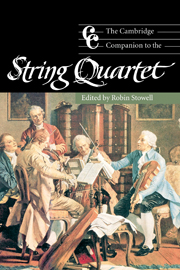Book contents
- Frontmatter
- Part I Social changes and organological developments
- Part II Celebrated ensembles
- Part III Playing string quartets
- Part IV The string quartet repertory
- 8 The origins of the quartet
- 9 Haydn, Mozart and their contemporaries
- 10 Beethoven and the Viennese legacy
- 11 The Austro-Germanic quartet tradition in the nineteenth century
- 12 Traditional and progressive nineteenth-century trends: France, Italy, Great Britain and America
- 13 Nineteenth-century national traditions and the string quartet
- 14 The string quartet in the twentieth century
- 15 The string quartet as a foundation for larger ensembles
- Notes
- Select bibliography
- Index
15 - The string quartet as a foundation for larger ensembles
from Part IV - The string quartet repertory
Published online by Cambridge University Press: 28 September 2011
- Frontmatter
- Part I Social changes and organological developments
- Part II Celebrated ensembles
- Part III Playing string quartets
- Part IV The string quartet repertory
- 8 The origins of the quartet
- 9 Haydn, Mozart and their contemporaries
- 10 Beethoven and the Viennese legacy
- 11 The Austro-Germanic quartet tradition in the nineteenth century
- 12 Traditional and progressive nineteenth-century trends: France, Italy, Great Britain and America
- 13 Nineteenth-century national traditions and the string quartet
- 14 The string quartet in the twentieth century
- 15 The string quartet as a foundation for larger ensembles
- Notes
- Select bibliography
- Index
Summary
Introduction
Ensemble combinations based on the string quartet have inspired some of the most expressive and intense pieces of all chamber music. The various genres examined in this survey attracted a remarkable array of composers, so their vast field of work can only be given a brief overview here. There is no space for detailed musical analysis or even a listing of every work of notable significance. Such enduring masterpieces as Mozart's G minor Quintet and Schubert's C major Quintet are illustrations of the inspiration afforded by the addition to the quartet of just one stringed instrument. However, the necessity to integrate extra players within an established quartet means that such works have tended to find their way into the concert hall only on an occasional basis. Long before these pieces were familiar through recordings, Walter Cobbett in 1929 went so far as to advocate the formation of string quintets specifically for touring purposes, as a way of doing justice to both the quality and the quantity of the repertory. The age of recording has consolidated the reputation of many of the pieces discussed below, including larger-scale string pieces such as Brahms' sextets and Mendelssohn's Octet, whose live performance has continued to be inhibited by practical and economic considerations.
Since the middle of the nineteenth century the medium of the piano quintet has become established as an important element in the repertories of both pianists and string quartets, with masterly contributions from such front-rank composers as Borodin, Brahms, Dvořák, Elgar, Fauré, Schumann, Shostakovich and Schnittke. Their various solutions to the balance of form, content and texture illustrate the distinctive versatility of the medium. Many of these composers also wrote for the closely related piano quartet, representative of a large body of chamber music which dispenses with a second violin and thus strictly lies outside the scope of this chapter.
- Type
- Chapter
- Information
- The Cambridge Companion to the String Quartet , pp. 310 - 327Publisher: Cambridge University PressPrint publication year: 2003

